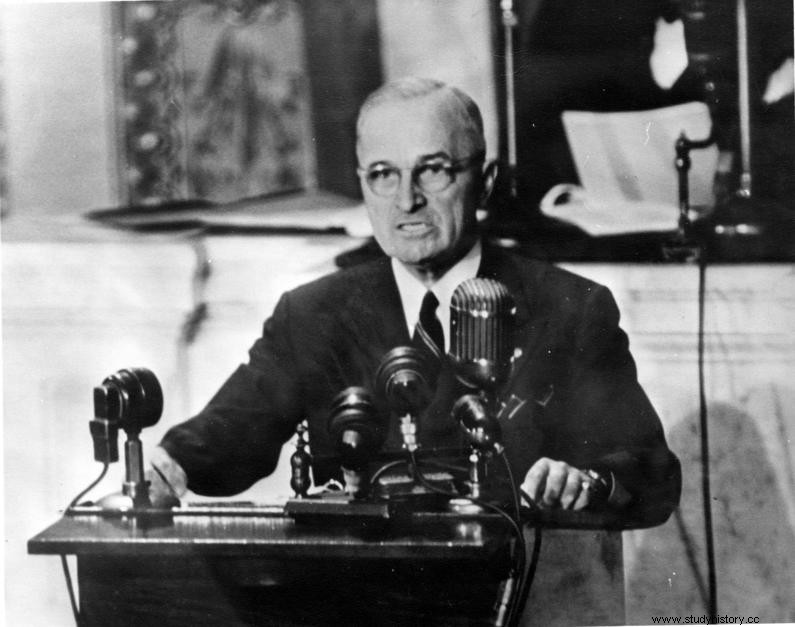- The United States and the USSR were the two great victors of the Second World War, but the incompatibility of their political and economic models led them to mistrust each other.
- On the one hand, the United States defends the capitalist model, based on private property and liberalism, but also multipartyism, freedom and democracy.
- The USSR prioritized equality, economic planning and the disappearance of private property in favor of the interventionist state.
- At Fulton, in the presence of Truman, Churchill calls for "defense to the free world", which denounces the "iron curtain" which separates Eastern and Western Europe.
- Irano-Soviet crisis of 1946:Iran demands the withdrawal of Soviet troops from its territory.
- Greece Civil War:Britain not wishing to see the country fall into communist hands, Churchill reached an agreement in Moscow in 1944 with Stalin.
March 12 and September 22, 1947

Characters
Harry Truman
Andrei Zhdanov
Procedure
For the USA, the return to isolationism appears contrary to their interests. The hour of international responsibilities for the most powerful nation in the world has arrived. On March 12, 1947, President Truman announced to Congress that the United States was taking over from the United Kingdom in Greece and Turkey to prevent them from falling into the communist camp.
US President Harry Truman defines his doctrine of containment which is oriented on two main axes:
- to stem the expansion of the policy of the USSR (containment );
- to help Europe to rebuild itself because misery is synonymous with communism.
For the USSR, the constitution of a sphere of influence is illustrated by the "satellization" of the countries of the East (elimination of the non-Communist opposition in Poland in 1946; pressure of the Red Army on the territories under former Nazi occupation). The Soviet response to the Truman Doctrine comes a few months later.
The 3 th Secretary of the Communist Party of the Soviet Union, Andrei Zhdanov, presents his doctrine against imperialism in 1947:
- it denounces an imperialist and anti-democratic camp led by the USA;
- he values the anti-imperialist and democratic forces led by the USSR;
- he invites the Eastern States to imitate the Soviet model;
- to distinguish themselves from "western bourgeois democracies", the states of Eastern Europe choose to call themselves "people's democracies".
Consequences
- By stating these two doctrines, the two powers declare their complete rupture. The world is split into two distinct blocks:the Western Block and the Eastern Block. Thus begins a period of building alliances and ending cooperation between former allies.
- The April 1947 Moscow conference on Germany was a failure.
- To stem the USSR, Truman announced that he would help "free countries" and launched the Marshall Plan in 1947. The massive influx of capital enabled rapid reconstruction but above all anchored Western Europe in the American model of free market economy.
- The West crystallizes around NATO and the European Economic Community.
- The USSR in return created a communist information office (Cominform), its own military alliance (Warsaw Pact, 1955) and its own economic organization in response to the Marshall Plan (Comecon, 1949).
- The “protective glacis” reached its climax with the Prague coup in 1948.
- Indirect confrontations will follow (Korean War in 1950) and the determination of each to maintain its position is felt by the blockade of Berlin in 1948 or the "witch hunt" in the United States.
- The confrontation marks the starting point of the Cold War:the confrontation between the blocs is above all ideological and takes the form of indirect confrontations, military-political deterrence operations and the consolidation of spheres of influence.
